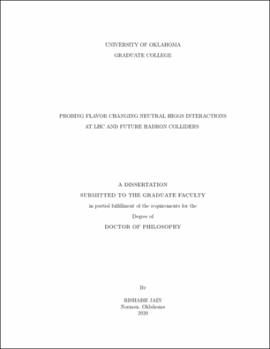| dc.description.abstract | In this dissertation, we discuss the prospect of discovering flavor changing neutral Higgs (FCNH) interactions with quarks and leptons at current and future hadron colliders. Particularly, we have looked for $t \to c h^0$ and $\phi^0 \to \tau^{\pm} \mu^{\mp}$, where $\phi^0$ could be a CP-even scalar \bigg[$h^0$ (lighter), $H^0$ (heavier) \bigg ] or a CP-odd pseudo-scalar ($A^0$). A general two Higgs doublet model (gTHDM) is used to simulate $t \to c h^0$ and $\phi^0\to \tau^{\pm} \mu^{\mp} $ decays. The LHC measurements of the light Higgs boson ($h^0$) favor
the decoupling limit of gTHDM, in which the couplings of $h^0$
approach Standard Model values.
In this limit, FCNH couplings of the light Higgs boson $h^0$ are
naturally suppressed by a small mixing parameter $\cos(\beta-\alpha)$,
while the FCNH couplings of heavier neutral Higgs bosons $H^0, \mathrm{and} A^0$
are sustained by $\sin(\beta-\alpha) \sim 1$. Promising results are found for the LHC
collision energies $\sqrt{s} = 13$ TeV and 14 TeV. In addition, we study the discovery potential of future pp colliders, with $\sqrt{s} = $ 27 TeV and 100 TeV. For $\phi^0 \to \tau^{\pm}\mu^{\mp}$,
we evaluate the production rate of physics background from dominant processes ($\tau^+\tau^-, WW, ZZ, Wq, Wg, t\bar{t}$) with realistic acceptance
cuts and tagging efficiencies. For $t \to c h^0$, where top is coming from top pair production, we consider $h^0 \to WW^* \to \ell^+ \ell^- + \slashed{E}_T$ and $h^0 \to \tau^+ \tau^- \to \ell^+ \ell^- + \slashed{E}_T$ and another top decaying hadronically to a b quark and two light jets. For this report we have studied $h^0 \to WW^*$ and $h^0 \to \tau^+ \tau^-$ separately. Our analysis suggests a reach of 5$\sigma$ or better, with integrated luminosity $\mathcal{L}$ = 3 $ab^{-1}$ and $\sqrt{s}$ = 13, 14 and 27 TeV for $\lambda_{tc}\leq 0.064$, under the current ATLAS limits for both light Higgs decay mode separately. For $h^0 \to WW^*$ we have also presented the discovery potential at 100 TeV. | en_US |

